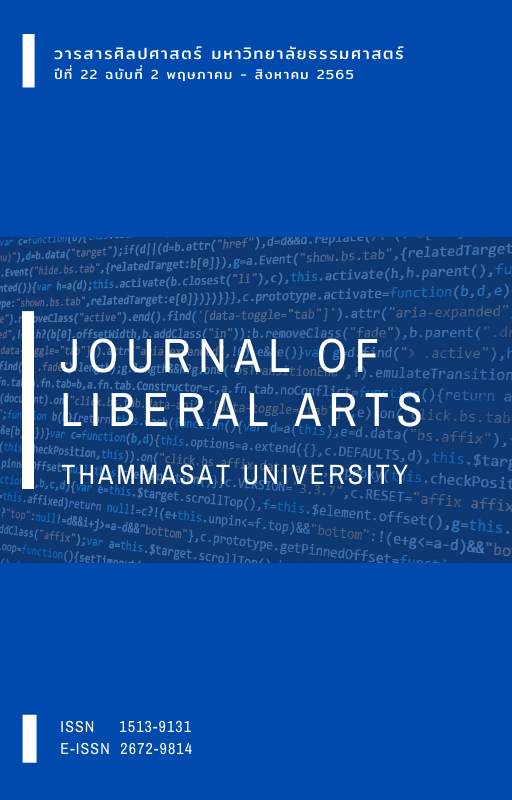“ธรรมชาติกำลังพูด”: การวิเคราะห์วาทกรรมที่เกี่ยวข้องกับธรรมชาติในคลิปวีดิโอ “Julia Roberts Is Mother Nature”
Main Article Content
บทคัดย่อ
บทความวิจัยชิ้นนี้เป็นส่วนหนึ่งของการศึกษาตัวบทวรรณกรรมสิ่งแวดล้อม จัดทำขึ้นเพื่อศึกษาคลิปวีดิโอขนาดสั้นชิ้นหนึ่งในชุดวีดิโอ “Nature is Speaking” (2557-2559) โดยองค์กร Conservation International (CI) แคมเปญรณรงค์อนุรักษ์สิ่งแวดล้อมนี้ดำเนินเรื่องโดยผู้พูดซึ่งเรียกขานตนเองว่า “ธรรมชาติ” โดยคลิปวีดิโอ “Julia Roberts Is Mother Nature” (2557) เป็นชิ้นงานที่มียอดรับชมสูงสุดมากกว่าสิบเอ็ดล้านครั้งทางเว็บไซต์ YouTube.com งานวิจัยนี้ดำเนินการผ่านการวิเคราะห์วาทกรรมที่เกี่ยวข้องกับธรรมชาติและสิ่งแวดล้อมและการอ่านตัวบทอย่างละเอียด
จากการวิจัยพบว่า ตัวบทนี้ได้ใช้วาทกรรมเกี่ยวกับธรรมชาติในรูปแบบผสมผสาน ได้แก่ วาทกรรมธรรมชาติอันดิบเถื่อน (wilderness) และวันหายนะสิ้นโลก (apocalypse) และหลีกเลี่ยงการถูกวิจารณ์ว่าขาดความสมจริงจากการให้เสียงพูดแก่ธรรมชาติด้วยกลวิธีการนำเสนอข้อเท็จจริงที่ยากจะปฏิเสธและอ้างอิงภาพจำที่สาธารณชนมีต่อธรรมชาติ อย่างไรก็ตาม แม้จะประสบความสำเร็จจากการมียอดรับชมและส่งต่อสูง แต่คลิปวีดิโอนี้นำเสนอธรรมชาติในลักษณะที่แยกขาดโดยสิ้นเชิงจากมนุษย์และวัฒนธรรม และให้ความสำคัญกับความแท้จริงและเป็นที่สุดของธรรมชาติ ซึ่งเป็นการนำเสนอที่มีปัญหา นอกจากนี้ จินตนาการเรื่องการแปรเปลี่ยนอย่างรุนแรงของโลกกายภาพอาจปลุกเร้าอารมณ์หวาดกลัวสิ้นหวังเกินควร เพื่อกระตุ้นให้ผู้ชมเลือกบริจาคเงินสนับสนุน อันเป็นการนำเสนอหนทางการแก้ปัญหาซึ่งเกี่ยวข้องกับรูปแบบองค์กรผู้ผลิตและเป้าหมายแอบแฝงในการสื่อสารเรื่องปัญหาสิ่งแวดล้อม
Downloads
Article Details

อนุญาตภายใต้เงื่อนไข Creative Commons Attribution-NonCommercial-NoDerivatives 4.0 International License.
เอกสารอ้างอิง
Boonpromkul, P. (2017). An Ecocritical Reading of Hayao Miyazaki’s Nausicaa of the Valley of the Wind: Territory, Toxicity, and Animals. Journal of Liberal Arts, Thammasat University, 17(1), 119-145.
Britannica. (2019). Naturalism. In Encyclopædia Britannica. https://www.britannica.com/topic/naturalism-art
Buell, L. (2005). The Future of Environmental Criticism. Blackwell Publishing.
Buell, L., Heise, U. K., & Thornber, K. (2011). Literature and Environment. Annual Review of Environment and Resources, 36, 417-440. https://doi.org/10.1146/annurev-environ-111109-144855
Clark, T. (2011). The Cambridge Introduction to Literature and the Environment. Cambridge UP.
Conservation International. (Producer). (2014, October 5). Julia Roberts Is Mother Nature [Video]. YouTube. https://www.youtube.com/watch?v=WmVLcj-XKnM
Dooren, T. V. (2016). Anthropocene [Video]. Environmental Humanities, UNSW. https://www.futurelearn.com/courses/remaking-nature/2/steps/119891
Garrard, G. (2012). Ecocriticism (2nd ed.). Routledge.
Gold, J. R., & Revill, G. (2004). Representing the Environment. Routledge.
Greenspan, I., Handy, F., & Katz-Gerro, T. (2012). Environmental Philanthropy: Is It Similar to Other Types of Environmental Behavior? Organization & Environment, 25(2), 111-130. https://www.jstor.org/stable/27068832
Gunter Jr., M. M. (2009). Nongovernmental Organizations. In Callicott, J. B., & Frodeman, R. (Eds.), Encyclopedia of Environmental Ethics and Philosophy Vol. 2 (pp. 95-9). Gale Cengage Learning.
Harman, G. (2014, October 6). Nature is Speaking: Will Consumers Listen?. The Guardian. https://www.theguardian.com/vital-signs/2014/oct/06/-sp-julia-roberts-harrison-ford-penelope-cruz-spacey-norton-redford-nature-is-speaking-videos
Heise, U. K. (2016). Imagining Extinction: The Cultural Meanings of Endangered Species. The University of Chicago Press.
Lang, C. (2011, May 12). Conservation International: “Are they any more than a green PR company?”. Redd-Monitor.
Meister, M. (2015). Celebrity Culture and Environment. In A. Hansen, & R. Cox. (Eds.), The Routledge Handbook of Environment and Communication (pp. 281-289). Routledge.
Rose, D. B. (2016). Separation of humans from nature—Colonisation [Video]. Environmental Humanities, UNSW. https://www.futurelearn.com/courses/remaking-nature/0/steps/16724
Whitmarsh, L. (2015). Analysing Public Perceptions, Understanding and Images of Environmental Change. In A. Hansen, & R. Cox (Eds.), The Routledge Handbook of Environment and Communication (pp. 339-353). Routledge.
Zeller Jr, T. (2011, May 17). Conservation International Duped By Militant Greenwash Pitch. Huffpost. https://www.huffpost.com/entry/conservation-international-lockheed-martin-video_n_863205


